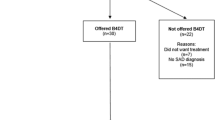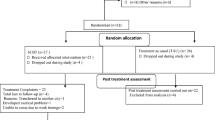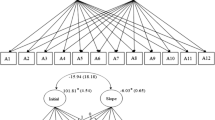Abstract
Cognitive behavioural therapy (CBT) for Social Anxiety Disorder (SAD) is an effective intervention for SAD, however, many individuals with SAD remain symptomatic at the end of CBT. Therefore, it is important to understand variables that influence patients’ responses to treatment. The present study investigated temporal changes in SAD symptoms as related to fear of negative evaluation (FNE) in a clinical sample of individuals with SAD who completed CBT. Participants with SAD (N = 175) completed self-report measures of SAD symptoms and FNE weekly across 12 weeks of group CBT. We used latent difference score dynamic modelling to explore the relationship between SAD symptom scores and FNE during CBT. Reductions in FNE were associated with subsequent reductions in SAD symptoms for individuals who showed a rapid response to treatment. The coupling of FNE and subsequent reductions in SAD symptoms was not seen in individuals not showing a rapid response. This study provides further support for the phenomenon of rapid response in CBT for SAD and suggests that mechanisms of change may be different for rapid responders as compared to non-rapid responders. The results of the current study may have implications for understanding the mechanisms underlying treatment response during CBT for SAD and for whom particular mechanisms are relevant.

Similar content being viewed by others
Notes
Each variable was evaluated for longitudinal measurement invariance. A confirmatory factor analysis (CFA) was first conducted for each measure. Measurement invariance was evaluated using the items retained in the CFAs. Weak longitudinal measurement invariance (i.e., equal factor loadings over time) was demonstrated for all measures before proceeding with the LDS analyses.
References
Acarturk, C., Cuijpers, P., van Straten, A., & de Graaf, R. (2009a). Psychological treatment of social anxiety disorder: A meta-analysis. Psychological Medicine,39(2), 241–254. https://doi.org/10.1017/S0033291708003590.
Acarturk, C., Smit, F., de Graaf, R., van Straten, A., ten Have, M., & Cuijpers, P. (2009b). Economic costs of social phobia: A population-based study. Journal of Affective Disorders,115(3), 421–429. https://doi.org/10.1016/j.jad.2008.10.008.
Aderka, I. M., Hofmann, S. G., Nickerson, A., Hermesh, H., Gilboa-Schechtman, E., & Marom, S. (2012). Functional impairment in social anxiety disorder. Journal of Anxiety Disorders,26(3), 393–400. https://doi.org/10.1016/j.janxdis.2012.01.003.
Akaike, H. (1973). Information theory and an extension of the maximum likelihood principle. In B. N. Petrov, & F. Csaki (Eds.), Proceedings of the 2nd international symposium on information theory (pp. 267–281). Budapest: Akademiai Kiado.
Antony, M. M., & Swinson, R. P. (2000). The shyness and social anxiety workbook: Proven techniques for overcoming your fears. Oakland, CA: New Harbinger Publications.
Antony, M. M., & Swinson, R. P. (2008). The shyness and social anxiety workbook: Proven techniques for overcoming your fears (2nd ed.). Oakland, CA: New Harbinger Publications.
Antony, M. M., Coons, M. J., McCabe, R. E., Ashbaugh, A., & Swinson, R. P. (2006). Psychometric properties of the Social Phobia Inventory: Further evaluation. Behaviour Research and Therapy,44(8), 1177–1185. https://doi.org/10.1016/j.brat.2005.08.013.
Arbuckle, J. L. (2016). Amos (Version 24.0) [Computer Program]. Chicago, IL: SPSS.
Barkowski, S., Schwartze, D., Strauss, B., Burlingame, G. M., Barth, J., & Rosendahl, J. (2016). Efficacy of group psychotherapy for social anxiety disorder: A meta-analysis of randomized controlled trials. Journal of Anxiety Disorders,39, 44–64. https://doi.org/10.1016/j.janxdis.2016.02.005.
Bentler, P. M. (1990). Comparative fit indexes in structural models. Psychological Bulletin,107, 238–246. https://doi.org/10.1037//0033-2909.107.2.238.
Bohn, C., Aderk, I. M., Schreiber, F., Stangier, U., & Hofmann, S. G. (2013). Sudden gains in cognitive therapy and interpersonal therapy for social anxiety disorder. Journal of Counselling and Clinical Psychology,81(1), 177–182. https://doi.org/10.1037/a0031198.
Browne, M. W. (2000). Cross-validation methods. Journal of Mathematical Psychology,44, 108–132. https://doi.org/10.1006/jmps.1999.1279.
Browne, M. W., & Cudeck, R. (1993). Alternative ways of assessing model fit. In K. A. Bollen & J. S. Long (Eds.), Testing structural equation models (pp. 136–162). Newbury Park, CA: Sage.
Buchholz, J. L., Abramowitz, J. S., Blakey, S. M., Reuman, L., & Twohig, M. P. (2019). Sudden gains: How important are they during exposure and response prevention for obsessive-compulsive disorder? Behavior Therapy,50, 672–681. https://doi.org/10.1016/j.beth.2018.10.004.
Burham, K. P., & Anderson, D. R. (2002). Model selection and multimodel inferences: A practical theoretic approcach (2nd ed.). New York, NY: Springer.
Burton, M., Schmertz, S. K., Price, M., Masuda, A., & Anderson, P. L. (2013). The relation between mindfulness and fear of negative evaluation over the course of cognitive behavioral therapy for social anxiety disorder. Journal of Clinical Psychology,69, 222–228. https://doi.org/10.1002/jclp.21929.
Butler, A. C., Chapman, J. E., Forman, E. M., & Beck, A. T. (2006). The empirical status of cognitive-behavioral therapy: A review of meta-analyses. Clinical Psychology Review,26(1), 17–31. https://doi.org/10.1016/j.cpr.2005.07.003.
Byrne, B. M. (2004). Testing for multigroup invariance using AMOS graphics: A road less traveled. Structural Equation Modeling,11, 272–300. https://doi.org/10.1207/s15328007sem1102_8.
Carpenter, J. K., Andrews, L. A., Witcraft, S. M., Powers, M. B., Smits, J. A., & Hofman, S. G. (2018). Cognitive behaviour therapy for anxiety and related disorders: A mata-analysis of randomized placebo-controlled trials. Depression and Anxiety,35(6), 502–514. https://doi.org/10.1002/da.22728.
Clark, D. M., & Wells, A. (1995). A cognitive model of social phobia. In M. Liebowitz & R. G. Heimberg (Eds.), Social phobia: Diagnosis, assessment, and treatment (pp. 69–93). New York, NY: Guilford Press.
Clark, D. M., Ehlers, A., Hackmann, A., McManus, F., Fennell, M., Grey, N., et al. (2006). Cognitive therapy versus exposure and applied relaxation in social phobia: A randomized controlled trial. Journal of Consulting and Clinical Psychlogy,74(3), 568–578. https://doi.org/10.1037/0022-006X.74.3.568.
Clerkin, E. M., Teahman, B. A., & Smith-Janik, S. B. (2008). Sudden gains in group cognitive-behavioral therapy for panic disorder. Behaviour Research and Therapy,46(11), 1244–1250. https://doi.org/10.1016/j.brat.2008.08.002.
Collins, K. A., Westra, H. A., Dozois, D. J. A., & Stewart, S. H. (2005). The validity of the brief version of the Fear of Negative Evaluation Scale. Anxiety Disorders,19, 345–359. https://doi.org/10.1016/j.janxdis.2004.02.003.
Connor, K. M., Davidson, J. R., Churchill, L. E., Sherwood, A., Foa, E., & Weisler, R. H. (2000). Psychometric properties of the Social Phobia Inventory (SPIN): New self-rating scale. British Journal of Psychiatry: The Journal of Mental Science,176, 379–386. https://doi.org/10.1192/bjp.176.4.379.
DeWall, N., Buckner, J. D., Lambert, N. M., Cohen, A. S., & Fincham, F. D. (2010). Bracing for the worst, but behaving the best: Social anxiety, hostility, and behavioral aggression. Journal of Anxiety Disorders,24, 260–268. https://doi.org/10.1016/j.janxdis.2009.12.002.
Dogaheh, E. R., Mohammadkhani, P., & Dolatshahi, B. (2011). Comparison of group and individual cognitive-behavioral therapy in reducing fear of negative evaluation. Psychological Reports,108, 955–962. https://doi.org/10.2466/02.21.PR0.108.3.955-962.
Erwin, B. A., Heimberg, R. G., Schneier, F. R., & Liebowitz, M. R. (2003). Anger experience and expression in social anxiety disorder: Pretreatment profile and predictors of attrition and response to cognitive-behavioral treatment. Behavior Therapy,34, 331–350. https://doi.org/10.1016/S0005-7894(03)80004-7.
Farrell, N. R., Ouimet, A. J., Rowa, K., Soreni, N., Swinson, R. P., & McCabe, R. E. (2016). Who gets better when? An investigation of change patterns in group cognitive behavioral therapy for obsessive-compulsive disorder. Journal of Obsessive-Compulsive and Related Disorders,10, 35–41. https://doi.org/10.1016/j.jocrd.2016.05.003.
Gatignon, H. (2010). Confirmatory factory analysis. In Statistical analysis of management data. New York, NY: Springer.
Goldin, P. R., Ziv, M., Jazaieri, H., Werner, K., Kraemer, H., Heimberg, R. G., et al. (2012). Cognitive reappraisal self-efficacy mediates the effects of individual cognitive-behavioral therapy for social anxiety disorder. Journal of Consulting and Clinical Psychology,80(6), 1034–1040. https://doi.org/10.1037/a0028555.
Grilo, C. M., White, M. A., Wilson, G. T., Gueorguieva, R., & Masheb, R. M. (2012). Rapid response predicts 12-month post-treatment outcomes in binge-eating disorder: Theoretical and clinical implications. Psychological Medicine,42(4), 807–817. https://doi.org/10.1017/S0033291711001875.
Hamagami, F., & McArdle, J. J. (2001). Advanced studies for individual differences linear dynamic models for longitudinal data analysis. In G. A. Marcoulides & R. E. Schumacker (Eds.), New developments and techniques in structural equation modeling (pp. 203–246). Mahwah, NJ: Erlbaum.
Hawley, L. L., Ho, M. R., Zuroff, D. C., & Blatt, S. J. (2006). The relationship of perfectionism, depression and therapeutic alliance during treatment for depression: Latent difference score analysis. Journal of Consulting and Clinical Psychology,74, 930–942. https://doi.org/10.1037/0022-006x.74.5.930.
Hawley, L. L., Ho, M. R., Zuroff, D. C., & Blatt, S. J. (2007). Stress reactivity following brief treatment for depression: Differential effects of psychotherapy and medication. Journal of Consulting and Clinical Psychology,75, 244–256. https://doi.org/10.1037/0022-006X.75.2.244.
Heimberg, R. G., & Becker, R. E. (2002). Cognitive behavioral group therapy for social phobia: Basic mechanisms and clinical strategies. New York, NY: Guilford Press.
Heinrichs, N., & Hofmann, S. G. (2001). Information processing in social phobia: A critical review. Clinical Psychology Review,21(5), 751–770. https://doi.org/10.1016/S0272-7358(00)00067-2.
Hilbert, A., Hildebrandt, T., Agras, W. S., Wilfley, D. E., & Wilson, G. T. (2015). Rapid response in psychological treatments for binge eating disorder. Journal of Consulting and Clinical Psychology,83(3), 649–654. https://doi.org/10.1037/ccp0000018.
Hofmann, S. G. (2004). Cognitive mediation of treatment change in social phobia. Journal of Consulting and Clinical Psychology,72(3), 392–399.
Hofmann, S. G. (2007). Cognitive factors that maintain social anxiety disorder: A comprehensive model and its treatment implications. Cognitive Behaviour Therapy,36, 193–209. https://doi.org/10.1080/16506070701421313.
Hofmann, S. G., & Bögels, S. M. (2006). Recent advances in the treatment of social phobia: Introduction to the special issue. Journal of Cognitive Psychotherapy,20(1), 3–5.
Hofmann, S. G., & Smits, J. A. J. (2008). Cognitive-behavioral therapy for adult anxiety disorders: A meta-analysis of randomized placebo-controlled trials. Journal of Clinical Psychiatry,69(4), 621–632.
Hofmann, S. G., Schulz, G., Meuret, S. M., Moscovitch, D. A., & Suvak, M. (2006). Sudden gains during therapy of social phobia. Journal of Consulting and Clinical Psychology,74(4), 687–697.
Jacobson, N. S., & Truax, P. (1991). Clinical significance: A statistical approach to defining meaningful change in psychotherapy research. Journal of Consulting and Clinical Psychology,59(1), 12–19.
Joreskog, K. G., & Sorbom, D. (1979). Advances in factor analysis and structural equation models. Cambridge, MA: Abt Books.
Kashdan, T. B., Elhai, J. D., & Breen, W. E. (2008). Social anxiety and disinhibition: An analysis of curiosity and social rank appraisals, approach-avoidance conflicts, and disruptive risk-taking behaviour. Journal of Anxiety Disorders,22, 925–939. https://doi.org/10.1016/j.janxdis.2007.09.009.
Kelly, M. A. R., Roberts, J. E., & Ciesla, J. A. (2005). Sudden gains in cognitive behavioral treatment for depression: When do they occur and do they matter? Behaviour Research and Therapy,43(6), 703–714. https://doi.org/10.1016/j.brat.2004.06.002.
Kessler, R. C., Chiu, W. T., Demler, O., & Walters, E. E. (2005). Prevalence, severity, and comorbidity of 12-month DSM-IV disorders in the National Comorbidity Survey replication. Archives of General Psychiatry,62(6), 617–627. https://doi.org/10.1001/archpsyc.62.6.617.
Kocovski, N. L., Fleming, J. E., Hawley, L. L., Huta, V., & Antony, M. M. (2013). Mindfulness and acceptance-based group therapy versus traditional cognitive behavioral group therapy for social anxiety disorder: A randomized controlled trial. Behaviour Research and Therapy,51, 88–898. https://doi.org/10.1016/j.brat.2013.10.007.
Kocovski, N. L., Fleming, J. E., Hawley, L. L., Ho, M.-H. R., & Antony, M. M. (2015). Mindfulness and acceptance-based group therapy and traditional cognitive behavioral group therapy for social anxiety disorder: Mechanisms of change. Behaviour Research and Therapy,70, 11–22. https://doi.org/10.1016/j.brat.2015.04.005.
Leary, M. R. (1983). A brief version of the Fear of Negative Evaluation Scale. Personality and Social Psychology Bulletin,9, 371–376.
Ledley, D. R., Heimberg, R. G., Hope, D. A., Hayes, S. A., Zaider, T. I., Van Dyke, M., et al. (2009). Efficacy of a manualized and workbook-driven individual treatment for social anxiety disorder. Behavior Therapy,40(4), 414–424. https://doi.org/10.1016/j.beth.2008.12.001.
Linardon, J., Brennan, L., & Xochitl de la Piedad, G. (2016). Rapid response to eating disorder treatment: A systematic review and meta-analysis. International Journal of Eating Disorders,49(10), 905–919. https://doi.org/10.1002/eat.22595.
Linett, A., Monforton, J., MacKenzie, M. B., McCabe, R. E., Rowa, K., & Antony, M. M. (2019). The Social Suspiciousness Scale: Development, validation, and implications for understanding social anxiety disorder. Journal of Psychopathology and Behavioral Assessment,41(2), 280–293. https://doi.org/10.1007/s10862-019-09724-3.
MacCallum, R. C., Browne, M. W., & Sugawara, H. M. (1996). Power analysis and determination of sample size for covariance structure modeling. Psychological Methods,1(2), 130–149. https://doi.org/10.1037/1082-989X.1.2.130.
Maresh, E. L., Teachman, B. A., & Coan, J. A. (2017). Are you watching me? Interacting effects of fear of negative evaluation and social context on cognitive performance. Journal of Experimental Psychopathology,8(3), 303–319. https://doi.org/10.5127/jep.059516.
Mayo-Wilson, E., Dias, S., Mavranezouli, I., Kew, K., Clark, D. M., Ades, A. E., et al. (2014). Psychological and pharmacological interventions for social anxiety disorder in adults: A systematic review and network meta-analysis. The Lancet Psychiatry,1(5), 368–376. https://doi.org/10.1016/S2215-0366(14)70329-3.
McArdle, J. J. (2001). A latent difference score approach to longitudinal dynamic analysis. In R. Cudeck, S. Toit, & D. Sörbum (Eds.), Structural equation modeling: Present and future (pp. 341–380). Lincolnwood, IL: Scientific Software International.
McArdle, J. J., & Hamagami, F. (2001). Latent difference score structural models for linear dynamic analyses with incomplete longitudinal data. In L. M. Collins & A. G. Sayer (Eds.), New methods for the analysis of change (pp. 139–175). Washington, DC: American Psychological Association.
McArdle, J. J., & Nesselroade, J. R. (2002). Growth curve analysis in contemporary psychological research. In J. Schinka & W. Velicer (Eds.), Comprehensive handbook of psychology: Vol 2. Research methods in psychology. Hoboken, NJ: Wiley.
Meredith, W., & Tisak, J. (1990). Latent curve analysis. Psychometrika,55, 107–122. https://doi.org/10.1007/bf02294746.
Moscovitch, D. A., McCabe, R. E., Antony, M. M., Rocca, L., & Swinson, R. P. (2007). Anger experience and expression across the anxiety disorders. Depression and Anxiety,25(2), 107–113. https://doi.org/10.1002/da.20280.
Moscovitch, D. A., Gavric, D. L., Senn, J. M., Santesso, D. L., Miskovic, V., Schmidt, L. A., et al. (2012). Changes in judgment biases and use of emotion regulation strategies during cognitive-behavioral therapy for social anxiety disorder: Distinguishing treatment responders from Nonresponders. Cognitive Therapy and Research,36(4), 261–271. https://doi.org/10.1007/s10608-011-9371-1.
Norton, P. J., & Price, E. C. (2007). A meta-analytic review of adult cognitive-behavioral treatment outcome across the anxiety disorders. Journal of Nervous and Mental Disease,195, 521–531.
Otto, M. W., Pollack, M. H., Maki, K. M., Gould, R. A., Worthington, J. J., Smoller, J. W., et al. (2001). Childhood history of anxiety disorders among adults with social phobia: Rates, correlates, and comparisons with patients with panic disorder. Depression and Anxiety,14(4), 209–213. https://doi.org/10.1002/da.1068.
Rapee, R. M., & Heimberg, R. G. (1997). A cognitive-behavioral model of anxiety in social phobia. Behaviour Research and Therapy,35(8), 741–756. https://doi.org/10.1016/S0005-7967(97)00022-3.
Rodebaugh, T. L., Holaway, R. M., & Heimberg, R. G. (2004). The treatment of social anxiety disorder. Clinical Psychology Review,24(7), 883–908. https://doi.org/10.1016/j.cpr.2004.07.007.
Steiger, J. H., & Lind, J. C. (1980, June). Statistically-based tests for the number of factors. Paper presented at the meeting of the Psychometric Society, Iowa City, IA.
Stein, M. B., & Kean, Y. M. (2000). Disability and quality of life in social phobia: Epidemiologic findings. American Journal of Psychiatry,157(10), 1606–1613. https://doi.org/10.1176/appi.ajp.157.10.1606.
Tang, T. Z., & DeRubeis, R. J. (1999). Sudden gains and critical sessions in cognitive-behavioral therapy for depression. Journal of Consulting and Clinical Psychology,67(6), 894–904. https://doi.org/10.1037//0022-006x.67.6.894.
Thorisdottir, S., Tryggvadottir, A., Saevarsson, S. T., & Bjornsson, A. S. (2018). Brief report: Sudden gains in cognitive behavioral group therapy and group psychotherapy for social anxiety disorder among college students. Cognitive Behaviour Therapy,47, 462–469. https://doi.org/10.1080/16506073.2018.1466909.
Vassilopoulos, S. (2005). Social anxiety and the vigilance-avoidance pattern of attentional processing. Behavioural and Cognitive Psychotherapy,33, 13–24. https://doi.org/10.1017/S1352465804001730.
Versalla, M. V., Piccirillo, M. L., Potter, C. M., Olino, T. M., & Heimberg, R. G. (2016). Anger profiles in social anxiety disorder. Journal of Anxiety Disorders,37, 21–29. https://doi.org/10.1016/j.janxdis.2015.10.008.
Watson, D., & Friend, R. (1969). Measurement of social-evaluative anxiety. Journal of Consulting and Clinical Psychology,33(4), 448–457. https://doi.org/10.1037/h0027806.
Wells, A., Clark, D. M., Salkovskis, P., Ludgate, J., Hackmann, A., & Gelder, M. (1995). Social phobia: The role of in-situation safety behaviors in maintaining anxiety and negative beliefs. Behavior Therapy, 26, 153–161. https://doi.org/10.1016/S0005-7894(05)80088-7.
Funding
There are no sources of funding to declare.
Author information
Authors and Affiliations
Corresponding author
Ethics declarations
Conflict of Interest
Karen Auyeung, Lance L. Hawley, Kevin Grimm, Randi McCabe, and Karen Rowa declares that there are no potential conflicts of interest
Ethical Approval
All procedures performed in current study were in accordance with the Ethical Standards of the Ethical Committee of Ghent University and with the 1964 Helsinki Declaration and its later amendments or comparable ethical standards.
Informed Consent
Informed consent was obtained from all individual participants included in the study.
Animal Rights
This article does not contain any studies with animals performed by any of the authors.
Additional information
Publisher's Note
Springer Nature remains neutral with regard to jurisdictional claims in published maps and institutional affiliations.
Electronic supplementary material
Below is the link to the electronic supplementary material.
Rights and permissions
About this article
Cite this article
Auyeung, K., Hawley, L.L., Grimm, K. et al. Fear of Negative Evaluation and Rapid Response to Treatment During Cognitive Behaviour Therapy for Social Anxiety Disorder. Cogn Ther Res 44, 526–537 (2020). https://doi.org/10.1007/s10608-020-10077-5
Published:
Issue Date:
DOI: https://doi.org/10.1007/s10608-020-10077-5




